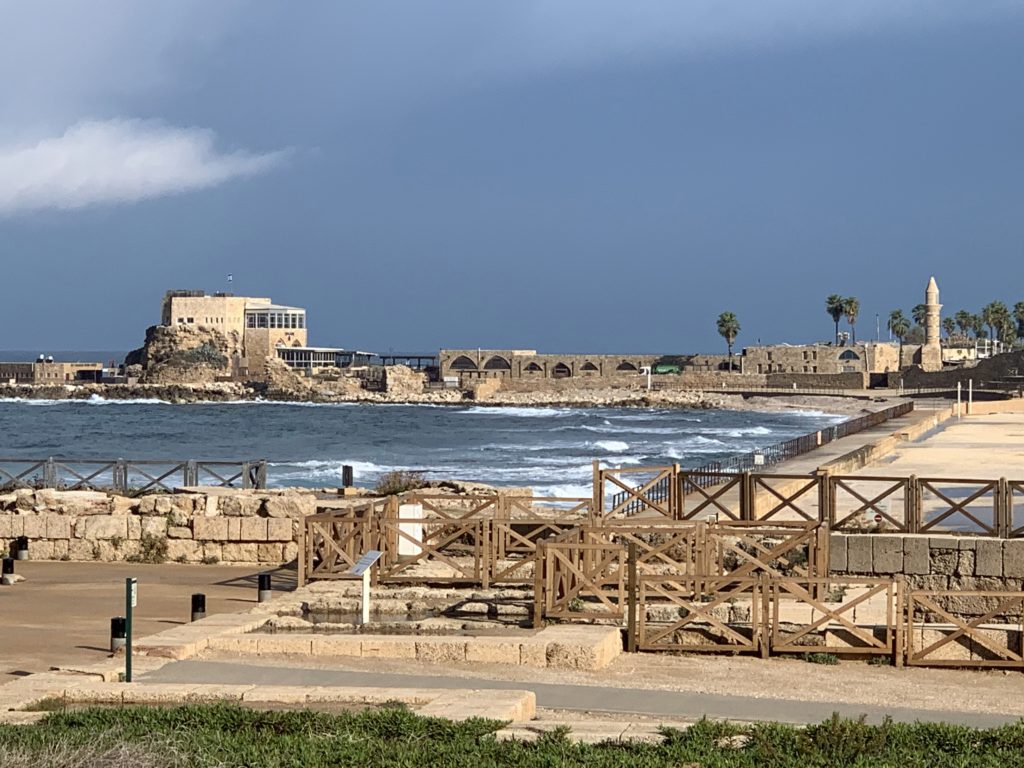Caesarea Maritima / Caesarea Palestina
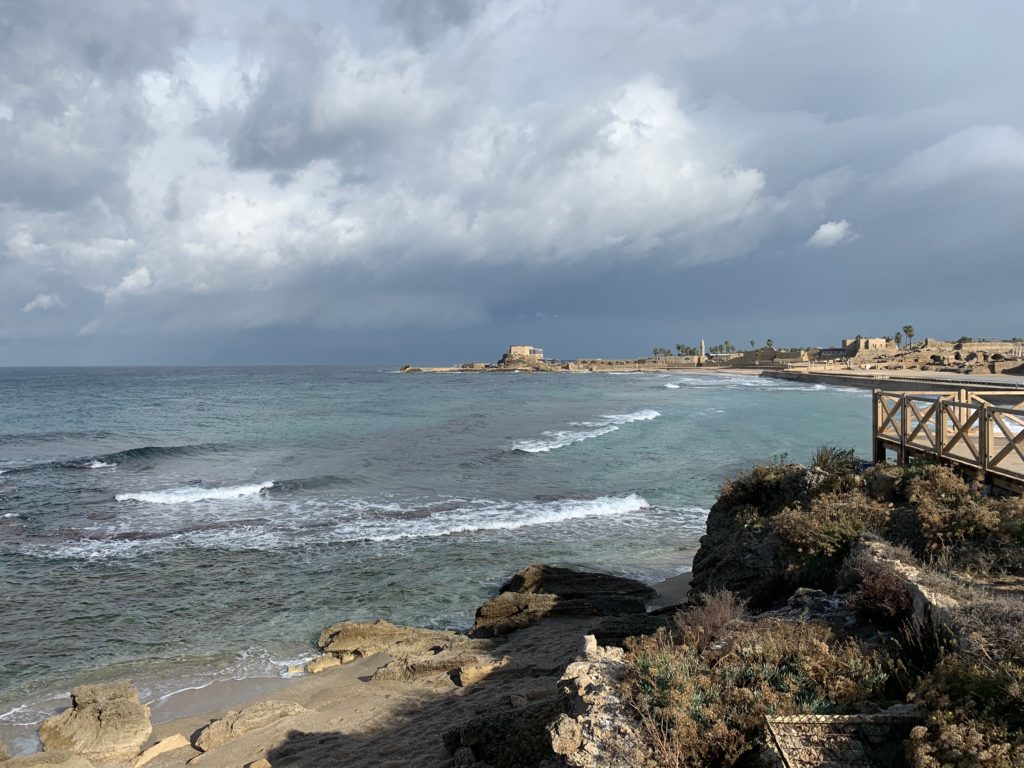
Intertestamental Period
In the 3rd century BC the Persians gave the area to the Phoenicians who built a small anchorage here and named it Strato’s Tower. The site had been controlled by the Sidonians, but the Romans under Octavian (who later became Augustus Caesar and the first emperor of the Roman Empire, 22 BC–AD 14) gave control of the coast between Joppa and Dor to Herod the Great (30 BC).
Caesarea served as the capital of Palestine for about 600 years — after the Romans reclaimed the region in AD 6. However, before that, Pompey (consul from 70 BC, triumvir 61–54 BC) controlled Caesarea from 66 BC and Augustus Caesar awarded the city to Herod in 22 BC.
Herod the Great built the city between 22–10 BC. He had convinced Rome to subsidize construction to give the Romans a harbor in the eastern Mediterranean. Herod’s construction took place over a small fishing village named Strato’s Tower. He dedicated the city to Caesar Augustus. To distinguish it from a multitude of other cities named Caesarea, it became known as Caesarea Maritima or Caesarea Palestina. The city was known for the splendor of its buildings — something for which Herod the Great was well known. According to Hohlfelder,
The primary source for Herodian Caesarea is the ancient historian Flavius Josephus (JW 1.408–14; Ant. 15.331–41). Although not a contemporary of the king, he knew Caesarea and its history well. We are fortunate to have not only his description of Herod’s city at its inception but also an account of the actual building of the Outer Basin of Sebastos as well—a literary description that is unique in ancient texts.
— Robert L. Hohlfelder, “Caesarea (Place),” in The Anchor Yale Bible Dictionary, 6 vols., ed. David Noel Freedman (New York: Doubleday, 1992), 799 [link inserted in text for online editions of Josephus’ works]
- Septic system: Herod designed it so the incoming tide would flush any waste in the septic pipes into the sea.
- Herod’s Palace: This building sat on the first bit of land that juts out into the sea. The apostle Paul was probably imprisoned close by.
- Governor’s Palace: Roman governors maintained a residence in Caesarea — mostly in Herod’s palace. Archaeological excavations in the palace area indicate a larger complex built atop Herod’s original building by the Roman governors.
- Inscription: One testifies to the governance of Pontius Pilate (AD 26–36). Antonio Frova found it in the ruins of the theater in 1961 where it had been repurposed to repair a stairway. It reads: “Pontius Pilate, Prefect of Judaea, made and dedicated the Tiberieum to the Divine Augustus.” A tiberieum consisted of a temple dedicated to a Roman emperor, who was considered a deity. The inscription uses the title of “Prefect” (equivalent to the New Testament’s ἡγεμών, hēgemōn, “governor”) for Pilate, not “Procurator” (for which the Greek term was ἐπίτροπος, epitropos). The prefect functioned more in the realm of the military than the procurator. Thus this inscription supports the historical accuracy of the Scriptures. See Lawrence Mykytiuk, “New Testament Political Figures Confirmed,” Biblical Archaeology Review 43, no. 5 (September/October 2017): 50–59, 65 for a helpful discussion of the archaeological evidences confirming the accuracy and historicity of the New Testament.
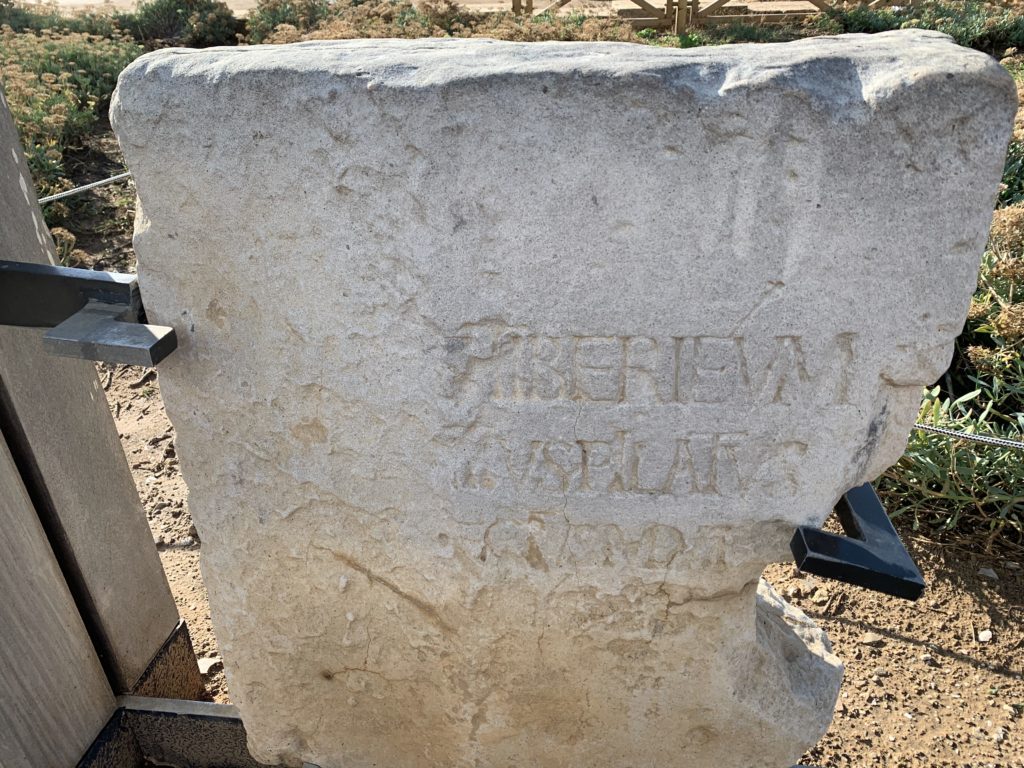
- Hippodromes: Herod built the original hippodrome as an amphitheater located at the seaside between his palace and the harbor. The Mediterranean has eroded away the western seating, leaving only the eastern seating with the dignitary’s stand. It could hold over 12,000 spectators. This facility measured 163 feet by 943 feet, providing adequate room for a variety of sports, including those involving horses (like chariot races). In the mid-2nd century AD, a larger hippodrome (1463 feet by 293 feet) was constructed farther inland. Estimates indicate 20,000–30,000 spectators could be seated in the hippodrome. During excavations of the larger hippodrome, archaeologists found a 45-foot tall obelisk of pink Aswan granite in 1996.

- Theater: Herod built the original theater, the earliest in the country. It is about 300 feet in diameter and seated about 4,000 spectators. Herod constructed it facing the Mediterranean so wind from the sea could carry voices into the theater seats. Entrances/exits for theater were called vomitaria, because when spectators went through the exits they spewed (vomited) the people into or out of the theater.
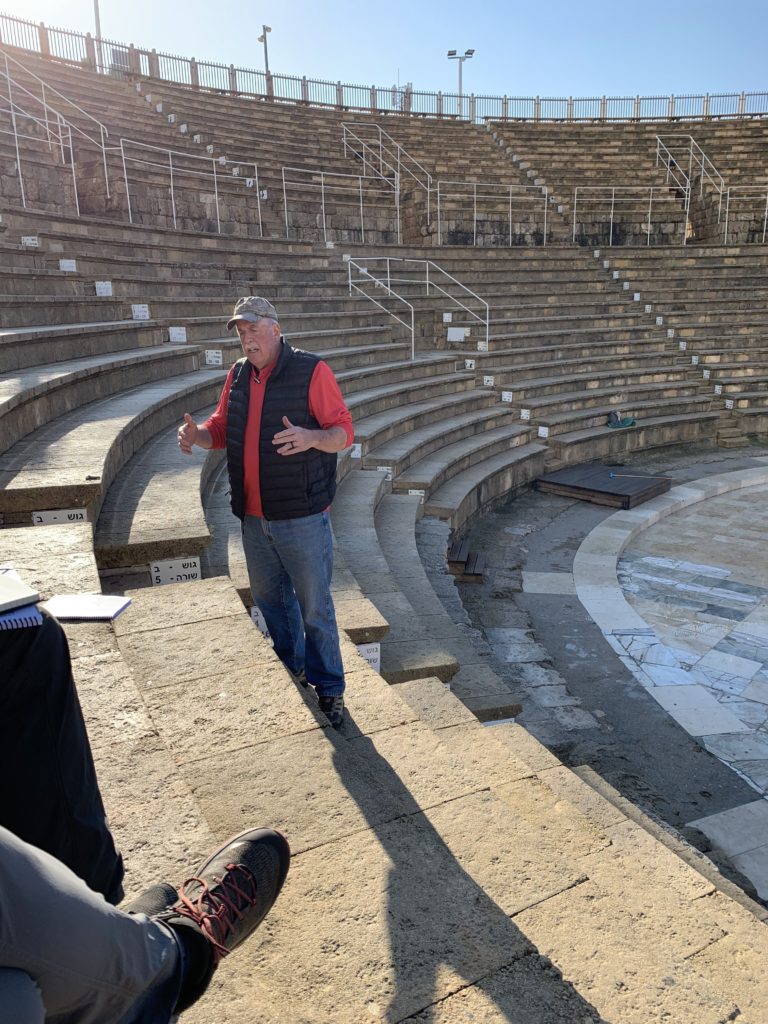

- Harbor: It held over 400 boats. Herod named it Limen Sebastos (Sebastos = Greek for Augustus). In the 1960s through the 1980s archaeologists conducted underwater surveys and excavations of Caesarea’s harbor. Robert L. Hohlfelder, “Caesarea Beneath the Sea,” Biblical Archaeology Review 8, no. 3 (May/June 1982): 42–47 describes the efforts and their significance to our understanding of the engineering skills and design employed in the harbor’s construction. Kevin Butcher offers the following description of this harbor’s construction:
A local tyrant had constructed a harbour in the late second century BC, which served as the innermost of the three basins of Herod’s new harbour. This triple ‘Harbour of Sebastos’ (Augustus), as it was called, was a vast structure on which no expense was spared. The basins were protected by two immense breakwaters, the shorter northern one being about 240 metres (262 yards) long and between 50 and 60 metres (55 and 65 yards) wide … The southern breakwater, which curved northwards, was about 500 metres (547 yards) long and 70 metres (77 yards) wide, supporting vaulted chambers and a broad quay. The entrance channel between the breakwaters was about 100 metres (109 yards) long and 20 to 30 metres (22 to 33 yards) wide, and marked by two towers, the largest of which is thought to have functioned as a lighthouse. A nearby shipwreck contemporary with the harbour’s construction contained wooden beams and volcanic ash and it has been argued that the ash was pozzolana from the Bay of Naples, imported to produce Roman hydraulic concrete (which sets underwater) for Herod’s breakwaters. The core of the breakwaters was constructed of huge blocks, some as large as 125 cubic metres (4414 cubic feet), composed of this hydraulic concrete mixed with rubble. The blocks were formed by pouring the concrete into submerged wooden moulds which may themselves have been made using imported materials shipped from Europe. This immense substructure was overlain with stone blocks and given additional protection from the sea in the form of a berm of rough stones. Despite the care that went into its construction, keeping Caesarea’s port in good working order proved an arduous task, as silting and seismic activity took their toll. By the third century the harbour was in bad shape, and it underwent extensive repairs during the reign of Anastasius. But by the seventh century the once magnificent haven had largely silted up and the city was in decline.
— Kevin Butcher, Roman Syria and the Near East (London: British Museum Press; Los Angeles: Getty Publications, 2003), 132
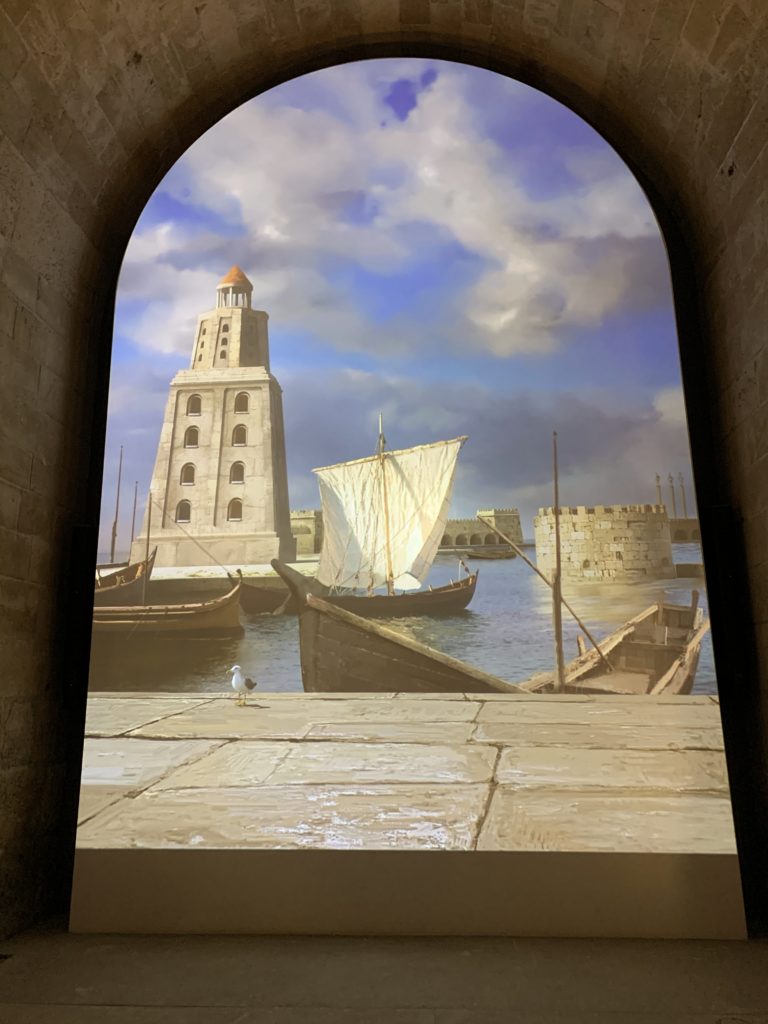
- Aqueducts: Evidence of two aqueducts exist between Caesarea and water sources to the northeast. Besides providing water for Caesarea, local communities along the route of the aqueduct tapped into the system to also be supplied. Herod built the high level western channel of the aqueduct (8 miles from springs on southern slope of Mt Carmel). Hadrian (AD 130) built the eastern low channel (6 miles from the Crocodile River, also called Nahal Tanninim) using Roman soldiers from the 2nd, 6th, 10th, and 22nd Legions serving in this area just before the Bar Kochba rebellion (Second Jewish Revolt, AD 132–35). The Romans built a dam across the Crocodile River to feed the low level aqueduct.
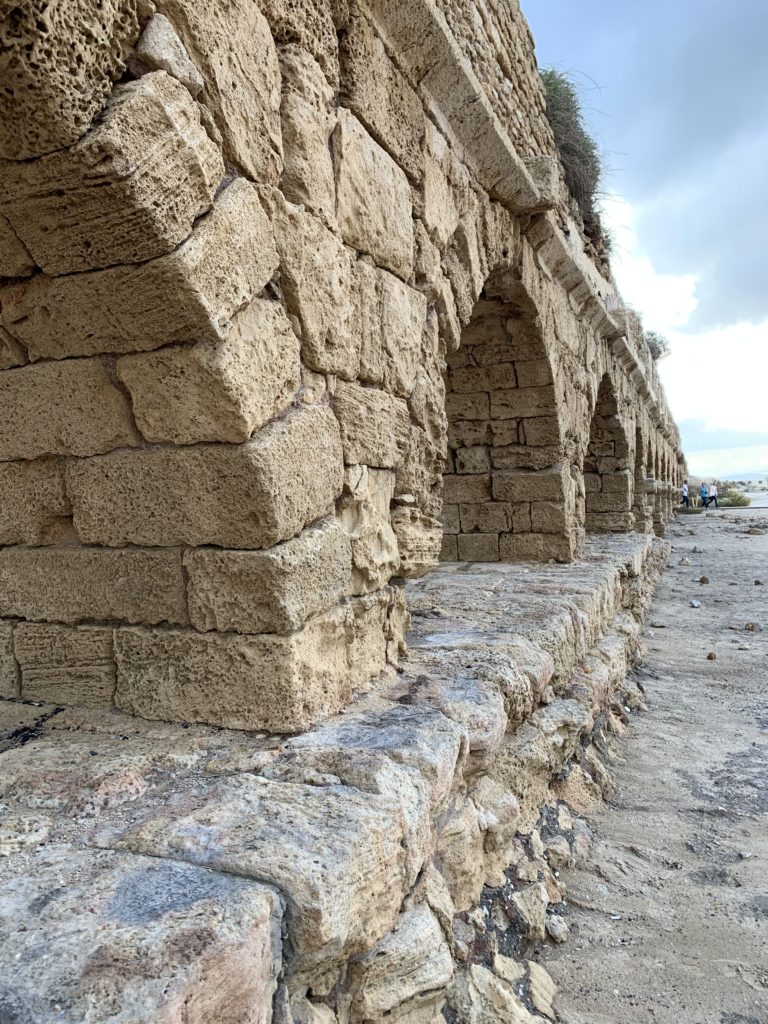
New Testament Connections
- Pontius Pilate — See discussion above about the inscription discovered at Caesarea (Matthew 27:1–31, 58, 62–66; Luke 3:1; 1 Timothy 6:12). See, also, R. Steven Notley, “Pontius Pilate,” Biblical Archaeology Review 43, no. 4 (2017): 40–49, 59–60.
- Cornelius — A Roman centurion of the Italian cohort, Cornelius became the first recorded Gentile conversion to Christ under Peter’s ministry (Acts 10:1–48). Luke’s description includes Cornelius among the “God-fearers” who had become Jewish proselytes.
- Peter — In Acts 11:1–18 Luke tells the account of Cornelius from the viewpoint of Peter’s involvement and how God had dealt with Peter.
- Herod Agrippa I (10 BC–AD 44) — This grandson of Herod the Great persecuted the early church. He died at Caesarea in AD 44 (Acts 12:1–25). It would not make much sense to place him on the stage of the theater at the time of his death, but while on his viewing platform in the seating at either the theater or the amphitheater — both allow late afternoon sunlight to reflect brightly from his spectacular robes.
- Paul — The apostle passed through this port several times and was imprisoned for 2 years (ca. AD 58–60), until he forced a decision by appealing to the Roman emperor as a Roman citizen (Acts 23–26). A Byzantine era mosaic floor at Caesarea quotes Romans 13:3.
- Felix and Festus — Both Roman procurators (Felix, AD 52–60; Festus, AD 60–62) interviewed the apostle Paul during his imprisonment at Caesarea (Acts 23:31–35; 24:27). Felix’s full name was most likely Marcus Antonius Felix. Josephus and a few Roman historians mention him. Festus’ full name was Porcius Festus. He succeeded Felix as procurator of Palestine. Josephus remains our key extrabiblical source for Festus.
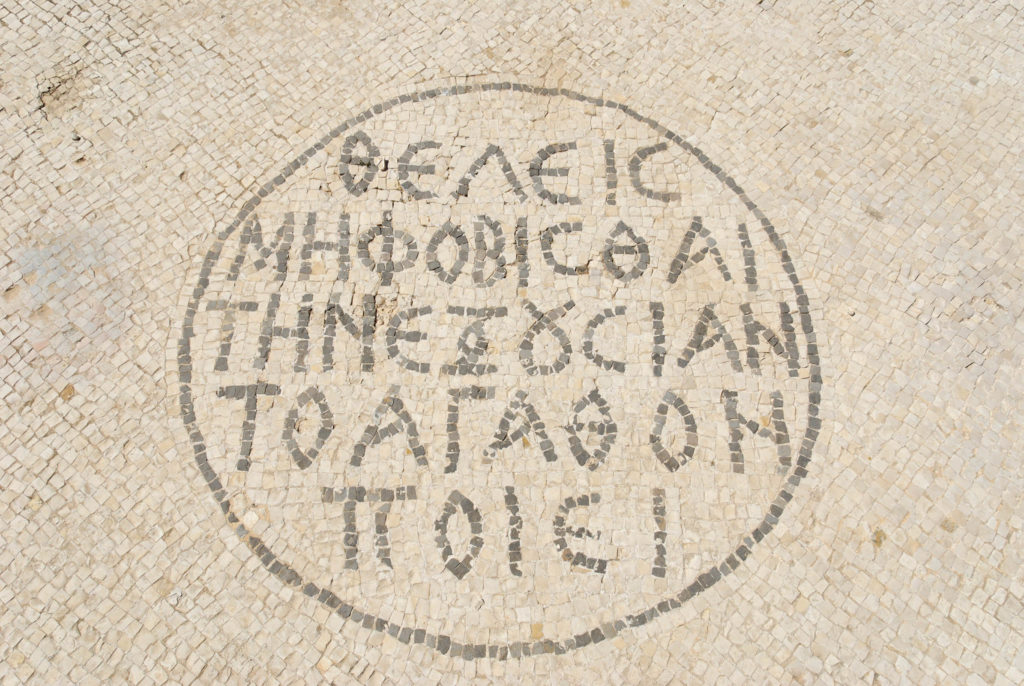
Later History
- AD 66 — The First Jewish Revolt (AD 66–70) began at the synagogue on the outskirts of the city. Roman soldiers slaughtered close to 20,000 Jews in an hour’s time at Caesarea.
- AD 130 — An earthquake severely damaged the port. Additional earthquakes in 363, 419, and 498 AD brought the port into ruin and disuse.
- 3rd and 4th centuries AD — Origen (AD 185–254) and Eusebius (AD 260–340) taught in the Christian school, which had a world-famous library second only to that in Alexandria, Egypt. Eusebius penned both his Ekklesiastikes Historia (Church History) and his Onomasticon (a geography) in Caesarea. Origen wrote his Hexapla (his textual comparison of the various Greek translations of the Old Testament with the Hebrew) here. [Links to these three titles take the reader to dependable online editions in English.]
- During the Byzantine era (AD 324–638) the government complex included a tax revenue office complex. Excavators discovered three mosaic floors in the portico one atop another. The earliest mosaic included a Greek inscription mentioning deputy assistants. In two reception rooms they found an inscription quoted from Romans 13:3 (see picture above).
- Despite the Crusaders gaining control of Caesarea in May 1101, the city eventually fell to the Muslim commander Saladin in July 1187 who left it in ruins. Under France’s King Louis IX, rebuilding took place (1251–1252), but the Mamluk sultan Baybars captured Caesarea in 1265 then soon after laid it in ruins again. Thus the city remained until 1878 when the Turks during the Ottoman Empire established a village of Bosnian refugees here.
- The Arab-Israeli War of 1948 once again destroyed the city (the Bosnian village) leaving only a small mosque present day visitors can see beside the harbor.
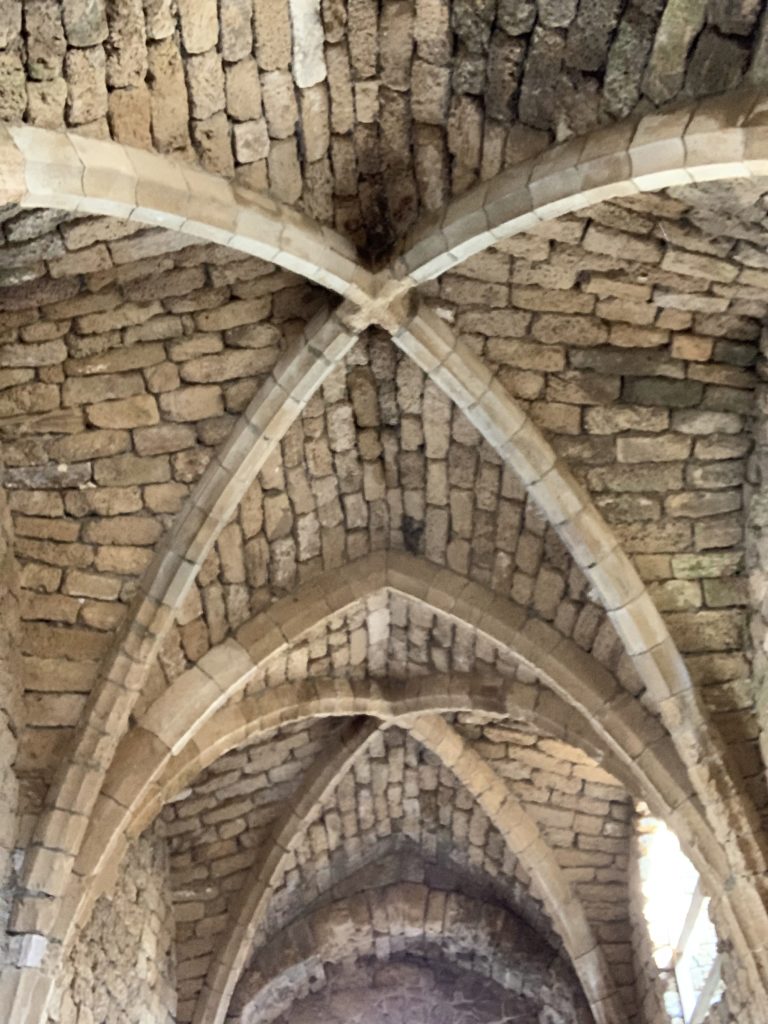
Archaeology
Since the 1950s, starting with Shmuel Yeivin (Israel Department of Antiquities), archaeologists have conducted excavation work at Caesarea nearly on a continuous schedule. Institutions involved in this archaeological work include Hebrew University, University of Haifa, Drew University, University of Colorado, University of Maryland, Rutgers University, Victoria University, University of Pennsylvania, Cornell University, and the Israel Antiquities Authority. Antonio Prova, with the Missione Archeologica Italiana, directed by Aristide Calderini, excavated the theater from 1959 to 1963. Avraham Negev, Gideon Foerster, Aaron Wegman, Edwin A. Link, and Michael Avi-Yonah all conducted excavations at Caesarea in association with Hebrew University and the Israel National Parks in the 1960s. In the 1970s Robert Bull of Drew University led a consortium (Joint Expedition to Caesarea Maritima, JECM) excavating various sites in Caesarea — see Robert J. Bull, “Caesarea Maritima: The Search for Herod’s City,” Biblical Archaeology Review 8, no. 3 (May/June 1982): 24–40.. At the same time another group from Hebrew University also conducted excavations (Daniel Bahat, Ehud Netzer, and Lee Levine). The 1980s saw the expansion of underwater excavations with a group known as the Caesarea Ancient Harbour Excavation Project (CAHEP) directed by Avner Raban (Hebrew University) and Robert Hohlfelder (University of Colorado). Kenneth Holum (University of Maryland) participated in more than 25 seasons of archaeological excavations at Caesarea, during which he directed the Combined Caesarea Expeditions (CCE).. In 1993 University of Pennsylvania’s Kathryn Gleason and Barbara Burrell extended Netzer’s excavations of the palace. In the 21st century, Yosef Porath (Israel Antiquities Authority) has conducted multiple seasons of archaeological excavations at Caesarea. With such a rich archaeological history, many key archaeologists could not be included in this blog post without substantial lengthening of its contents.
Resources
- Yosef Porath et al., “Caesarea,” in The New Encyclopedia of Archaeological Excavations in the Holy Land, ed. Ephraim Stern, 24–36 (Jerusalem: Israel Exploration Society; Washington, DC: Biblical Archaeology Society, 2008)
- Robert L. Hohfelder, Christopher Brandon, and John P. Oleson, “Constructing the Harbour of Caesarea on the Sea: New Evidence from the Romans Field Campaign of October 2005.”
- Yosef Porath, “Vegas on the Med: A Tour of Caesarea’s Entertainment District,” Biblical Archaeology Review 30, no. 5 (September/October 2004): 24–27, 29–32, 34–35.
- Kenneth G. Holum, “Caesarea: Herod and Beyond, Building Power, the Politics of Architecture,” Biblical Archaeology Review 30, no. 5 (September/October 2004): 36–45, 57.
- Barbara Burrell, Kathryn L. Gleason, and Ehud Netzer, “Uncovering Herod’s Seaside Palace,” Biblical Archaeology Review 19, no. 3 (May/June 1993): 50, 52–57, 76.
- Lindley Vann, “News from the Field: Herod’s Harbor Construction Recovered Underwater,” Biblical Archaeology Review 9, no. 3 (May/June 1983): 10–11, 14.

